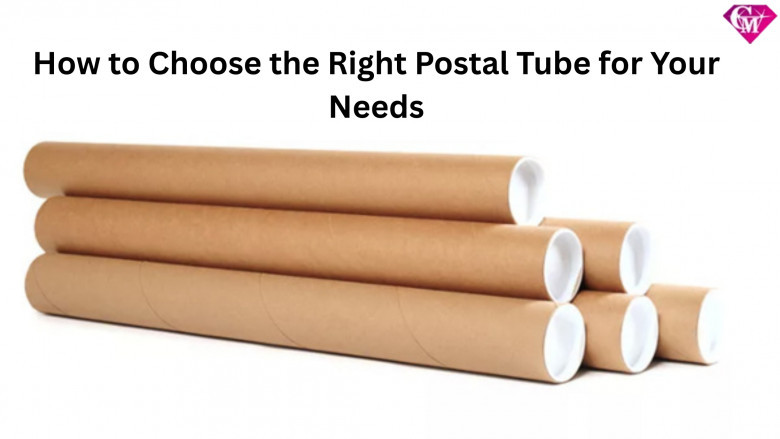views
When it comes to shipping or storing rolled items such as posters, blueprints, or artwork, postal tubes are one of the most reliable packaging solutions. Whether you're a business shipping products to customers or an artist preserving prints, using the right mailing tube ensures your items arrive undamaged. But with so many types of poster tubes and cardboard postal tubes available, how do you choose the best one for your needs?
In this guide, we’ll explore the key features, benefits, applications, types, and expert tips to help you select the perfect poster packaging tube.

What Are Postal Tubes?
Postal tubes—also known as mailing tubes or poster tubes—are cylindrical packaging materials typically made from cardboard. They are specifically designed for shipping or storing rolled documents, posters, artworks, maps, and other flexible or long items that shouldn’t be folded.
They come in a variety of lengths, diameters, and strengths, with most poster tubes for shipping being made from thick, spiral-wound cardboard that resists crushing.
Features of Quality Postal Tubes
When choosing the right postal tube, look out for the following features:
1. Material Strength
The best cardboard postal tubes are made from high-grade, spiral-wound paperboard, offering excellent resistance to crushing and bending. For heavier or more valuable items, choose a tube with thicker walls.
2. End Caps
Most tubes come with plastic or metal end caps. Ensure they fit snugly and stay in place during transit. Some heavy-duty options also include tamper-evident or screw-on caps for added security.
3. Size Options
Postal tubes vary in diameter and length. Choose the diameter based on how tightly your item can be rolled without damage. A diameter of 2–3 inches suits most posters, but large prints or plans might need wider tubes.
4. Custom Printing
If you're a business, consider branded poster packaging tubes with your logo or label. This adds professionalism and promotes your brand.
Benefits of Using Poster Tubes
Poster tubes for shipping offer a range of advantages over flat packaging:
1. Protection from Damage
Rolled items packed in a sturdy tube are far less likely to crease, tear, or get wet. The rigid cardboard offers solid protection even during long shipping journeys.
2. Space-Efficient
Because the item is rolled, it takes up less space than if shipped flat. This can reduce shipping costs and make handling easier.
3. Reusable and Eco-Friendly
Many cardboard postal tubes are made from recycled materials and can be reused multiple times, making them a sustainable packaging option.
4. Cost-Effective
For lightweight and flexible items, mailing tubes are often cheaper to ship than boxes of the same size.
Common Applications of Mailing Tubes
The uses of postal tubes span a wide range of industries and purposes:
-
Artists and photographers use poster tubes to ship prints, canvases, and photographs safely.
-
Architects and engineers transport large-format blueprints and technical drawings.
-
Retailers and e-commerce brands send posters, calendars, and display materials.
-
Educational institutions store diplomas, certificates, and academic documents.
-
Event organizers use tubes for promotional materials and banners.
Types of Postal Tubes
Not all poster packaging tubes are created equal. Here are some common types:
1. Standard Cardboard Postal Tubes
Ideal for everyday shipping needs, these tubes come in various sizes and wall thicknesses.
2. Heavy-Duty Tubes
Made with reinforced walls, these are perfect for shipping valuable or delicate items over long distances.
3. Telescopic Tubes
Adjustable in length, telescopic tubes are great for items of varying sizes. They're often used for architectural or engineering drawings.
4. Triangular and Square Tubes
These are designed to prevent rolling during transport, which some courier services prefer. They also stack more easily.
5. Plastic Mailing Tubes
Used when waterproof protection is essential. They're more durable but less eco-friendly than cardboard options.
Tips for Choosing the Right Poster Tube
Choosing the wrong mailing tube can result in damaged goods and dissatisfied customers. Keep these tips in mind:
1. Measure Before You Buy
Always know the dimensions of the item you intend to roll. Choose a tube slightly longer and wider to accommodate the item and any protective wrapping.
2. Mind the Wall Thickness
For light posters, a thin-walled tube is fine. For heavier items or longer shipping routes, choose thicker walls for extra protection.
3. Use End Caps Securely
Ensure the end caps are tight and secure. Use packing tape if needed to prevent accidental openings.
4. Label Clearly
Attach a clear, weather-resistant shipping label. Some tubes offer printed surfaces designed to accept labels more securely.
5. Choose Recyclable Options
If sustainability is important to you or your brand, go for cardboard postal tubes made from recycled materials.
Read More : https://www.crystalmailing.co.uk/blogs/news/tips-and-hacks-for-using-postal-tubes
Why Choose the Right Poster Packaging Tube?
Selecting the appropriate poster packaging tube can significantly impact your shipping success. Here’s why it matters:
-
Customer Satisfaction: Delivering items undamaged boosts trust and brand loyalty.
-
Reduced Returns: Proper packaging minimizes the risk of damage-related returns.
-
Professional Presentation: High-quality tubes show customers that you care about quality.
-
Cost Efficiency: The right size and strength mean fewer packaging materials and optimized shipping costs.
Conclusion
Whether you're shipping artwork, documents, or promotional materials, selecting the right postal tube is essential. From standard cardboard postal tubes to heavy-duty mailing tubes, understanding the features, benefits, and applications helps you make the best choice for your needs.
By choosing the right poster tubes for shipping, you ensure that your items arrive safely, your customers are happy, and your packaging remains cost-effective and environmentally responsible.
Invest a little time in selecting the proper poster packaging tube, and you'll avoid damage, improve your brand image, and ship smarter.






















Comments
0 comment